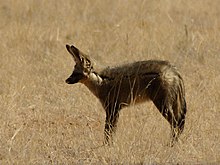Bat-eared fox: Difference between revisions
Seb az86556 (talk | contribs) |
Androstachys (talk | contribs) No edit summary |
||
| Line 34: | Line 34: | ||
*''Otocyon megalotis megalotis'' - South [[Zambia]], [[Botswana]], [[Namibia]], [[South Africa]] |
*''Otocyon megalotis megalotis'' - South [[Zambia]], [[Botswana]], [[Namibia]], [[South Africa]] |
||
*''Otocyon megalotis canescens'' - [[Ethiopia]], [[Somalia]] |
*''Otocyon megalotis canescens'' - [[Ethiopia]], [[Somalia]] |
||
==External links== |
|||
*[http://www.skullsunlimited.com/userfiles/image/variants_large_3027.jpg Skulls Unlimited] |
|||
==References== |
==References== |
||
Revision as of 07:30, 10 January 2010
| Bat-eared Fox[1] | |
|---|---|

| |
| Scientific classification | |
| Kingdom: | |
| Phylum: | |
| Class: | |
| Order: | |
| Family: | |
| Subfamily: | |
| Genus: | Otocyon Müller, 1835
|
| Species: | O. megalotis
|
| Binomial name | |
| Otocyon megalotis (Desmarest, 1822)
| |
The Bat-eared Fox (Otocyon megalotis) is a canid of the African savanna, named for its large ears. Fossil records show this canid to first appear during the middle Pleistocene, 0.781 million years or 781,000 years ago. [3]
The Bat-eared Fox has tawny fur with black ears, legs and parts of the face. It averages 55 cm in length (head and body), with ears 13 cm long. It is the only species in the genus Otocyon.[1]
The teeth of the Bat-eared Fox are much smaller than teeth of other canid species. This is an adaptation to its insectivorous diet, insects making up as much as 80% of its food intake.[4] The Bat-eared Fox visits termite hills, follows locust swarms and stays close to herds of zebras or antelopes in order to feed on the insects landing on their excrement. In addition to insects, the Bat-eared Fox eats rodents, birds and eggs, and sometimes fruits. Most of its water intake comes from the food it eats.
Bat-eared Foxes are mostly nocturnal animals that live in small groups consisting of mated pairs and their young. The pairs live in dens and typically raise two to five pups together. Mated pairs are very social and are monogamous, although it is unknown if they mate for life.
Due to its unusual teeth, the Bat-eared Fox was once considered as a distinct subfamily of canids (Otocyoninae). However, according to more recent examinations, it is more closely related to the true foxes of the genus Vulpes.[citation needed] Other research places the genus as an outgroup which is not very closely related to foxes. The Bat-eared Fox is an old species that was widely distributed in the Pleistocene era. In that time, it even lived in parts of West and South Asia.
Subspecies
There are two recognized subspecies of this fox:
- Otocyon megalotis megalotis - South Zambia, Botswana, Namibia, South Africa
- Otocyon megalotis canescens - Ethiopia, Somalia
External links
References
- ^ a b Wozencraft, W. C. (2005). "Order Carnivora". In Wilson, D. E.; Reeder, D. M. (eds.). Mammal Species of the World: A Taxonomic and Geographic Reference (3rd ed.). Johns Hopkins University Press. ISBN 978-0-8018-8221-0. OCLC 62265494.
- ^ Template:IUCN2008 Database entry includes justification for why this species is of least concern
- ^ Paleobiology Database: Otocyon Basic info.
- ^ Thompson, Paul. "Otocyon megalotis". Retrieved 2009-02-08.

